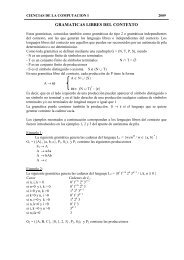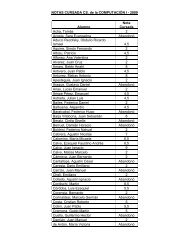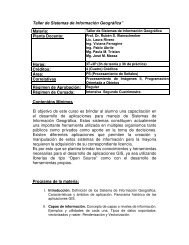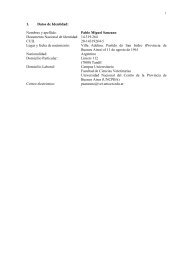Libro de Resúmenes / Book of Abstracts (Español/English)
Libro de Resúmenes / Book of Abstracts (Español/English)
Libro de Resúmenes / Book of Abstracts (Español/English)
You also want an ePaper? Increase the reach of your titles
YUMPU automatically turns print PDFs into web optimized ePapers that Google loves.
Resumenes 129<br />
Aproximación y simulación <strong>de</strong> un mo<strong>de</strong>lo <strong>de</strong> dispersión <strong>de</strong><br />
contaminantes en superficies esféricas<br />
Carmen Alicia Ramírez Bernate 1 , Geraldo Lúcio Diniz 2<br />
1 Maestria en Biomatemáticas, Facultad <strong>de</strong> Ciencias Basicas, Universidad <strong>de</strong> Quindio<br />
Carrera 15 Calle 12 Norte A.A. 460 – Armenia, Quindio, Colombia.<br />
aliciarb@uniquindio.edu.co<br />
2 Mathematics Department, ICET, Fe<strong>de</strong>ral University at Mato Grosso<br />
Av. Fernando Correa, 78.060-900 – Cuiabá/MT, Brazil<br />
geraldo@cpd.ufmt.br<br />
En este trabajo, presentamos una aproximación y simulación <strong>de</strong>l<br />
proceso evolutivo <strong>de</strong> la dispersión <strong>de</strong> contaminantes en superficies<br />
esféricas. El código numérico para la simulación es hecho por el método <strong>de</strong><br />
elementos finitos (MEF). En el mo<strong>de</strong>lo, consi<strong>de</strong>ramos el proceso <strong>de</strong> la<br />
difusión, el fenómeno <strong>de</strong> transporte por el medio, el <strong>de</strong>caimiento en sentido<br />
global y un término <strong>de</strong> fuente. Para la clásica ecuación <strong>de</strong> difusión-reacción<br />
obtuvimos la formulación débil en el sentido <strong>de</strong> aplicar el método <strong>de</strong><br />
elementos finitos. Los autores creen que la importancia <strong>de</strong>l trabajo<br />
<strong>de</strong>sarrollado conduce a su uso potencial en procesos <strong>de</strong> medio ambiente<br />
para la <strong>de</strong>finición <strong>de</strong> estrategias evaluativas, preventivas y <strong>de</strong> limpieza.<br />
Palabras Claves: Aproximación Numérica, Simulación Computacional,<br />
Dispersión, Método <strong>de</strong> Elementos Finitos, Superficie Esférica.<br />
Approximation and simulation for a mo<strong>de</strong>l <strong>of</strong> pollutant<br />
dispersal in spherical surfaces<br />
In this paper, we present an approach and simulation <strong>of</strong> evolutionary<br />
process <strong>of</strong> pollutant dispersal on spherical surfaces. The numerical co<strong>de</strong> <strong>of</strong><br />
simulations is ma<strong>de</strong> by finite elements method (FEM). In the mo<strong>de</strong>l, we<br />
consi<strong>de</strong>r the diffusion process, the transport phenomena by the mean, the<br />
<strong>de</strong>cay in global sense and a source term. For the classical diffusion-reaction<br />
equation we obtained the weak formulation in the sense <strong>of</strong> applying the<br />
finite elements method.<br />
This mo<strong>de</strong>l is being studied by group <strong>of</strong> Phenomena Mo<strong>de</strong>lling <strong>of</strong><br />
Macroscopic Diffusion in the Master <strong>of</strong> Biomathematics program at the<br />
University <strong>of</strong> Quindio, Colombia. The authors believe that the relevance <strong>of</strong><br />
the <strong>de</strong>veloped work lies in its potential use in environmental assessment<br />
processes for the <strong>de</strong>finition <strong>of</strong> evaluative, preventive and clean-up<br />
strategies.<br />
Keywords⎯ Numerical Approximation, Computational Simulation,<br />
Dispersion, Finite Elements Method, Spherical Surface.


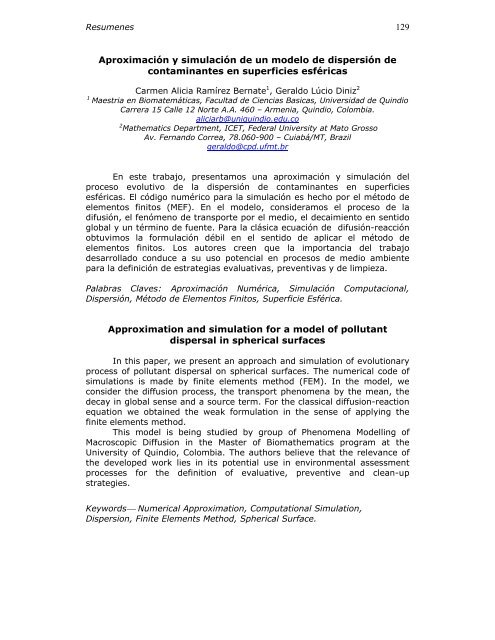
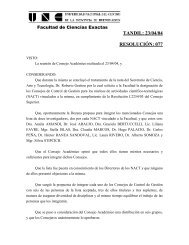
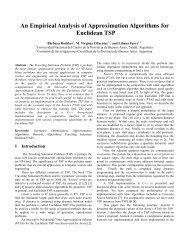
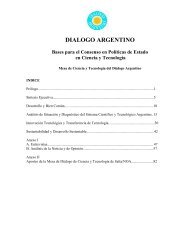
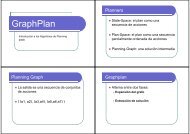
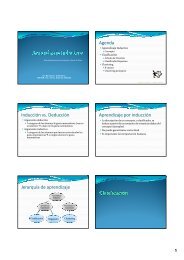
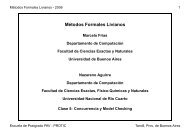
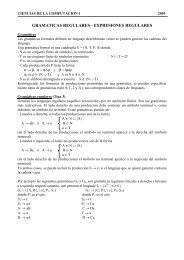
![Clase 13 [pdf]](https://img.yumpu.com/19616969/1/190x245/clase-13-pdf.jpg?quality=85)


